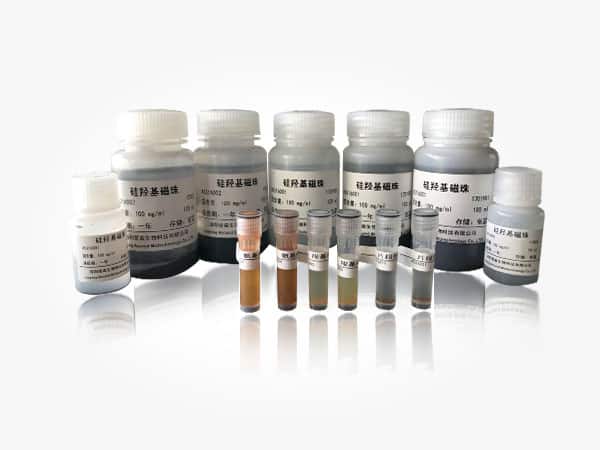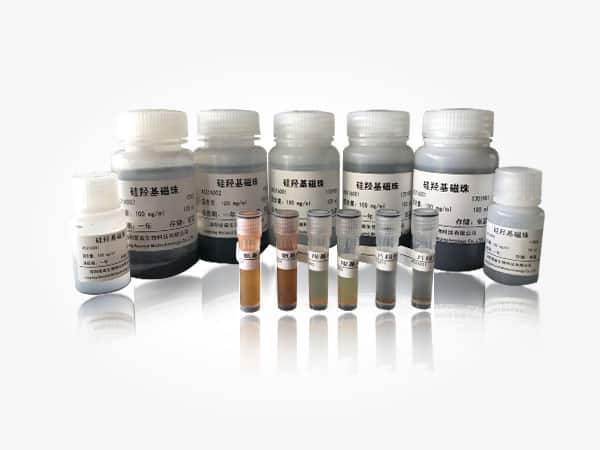Application of immunomagnetic beads in the field of biomedicine
Immunomagnetic bead technology is a technical method that appeared in the 1980s. Based on immunology, it has penetrated into various fields such as pathology, physiology, pharmacology, microbiology, biochemistry, and molecular genetics. It has become more and more widely used in immunoassays, cell separation, purification of biological macromolecules, and molecular biology.
Structure of immunomagnetic beads
Magnetic beads are composed of core metal particles (Fe2O3, Fe3O4), a polymer material (such as polystyrene, polyvinyl chloride) wrapped in the core outer layer, and the outermost functional ligand (such as -NH2, -COOH, -OH, -CHO) composition.
Application of immunomagnetic beads in the field of biomedicine

1. Cell sorting
Immunomagnetic bead cell sorting can separate very high purity cells from complex cell mixtures within a few minutes. When using nano-scale magnetic beads for cell sorting, the size of the magnetic beads and its composition make it biodegradable without activating the cells or affecting the function and vitality of the cells, and the physiological functions of the cells are also unchanged. Magnetically labeled cells can be used immediately for analysis and subsequent experiments.
Cell sorting can be divided into
a) Positive sorting (positive sorting): The cells bound by magnetic beads are the cells to be separated, which is suitable for flow analysis and cell-based analysis.
b) Negative sorting (negative sorting): The magnetic beads bind to unwanted cells, and the cells free in the supernatant are the desired cells.
Positive selection (left) and negative selection (right) are as follows:
1. Important indicators for magnetic separation of cells
Purity and yield depend on the specificity of the monoclonal antibody connected to the magnetic beads and the size (magnetic) of the magnetic beads. However, the yield of magnetic beads that are too small is not high, and magnetic beads that are too large will affect cell viability and cannot directly Upstream.
2. Protein/antibody separation and purification
The application of antibody (protein)-coated immunomagnetic bead purification technology does not require complicated chromatography equipment, and has no limitation on the clarity of the sample. It only requires a simple magnetic adsorption step to easily separate the monoclonal antibody from the monoclonal antibody expression product. Effectively solve the shortcomings of traditional chromatography technology.
3. Nucleic acid separation and purification
The binding of nucleic acid to magnetic beads mainly relies on electrostatic, hydrophobic and hydrogen bonding. The DNA/RNA in the cell or tissue is released under the action of the lysis solution. At this time, the surface-modified superparamagnetic silica nanomagnetic beads “specifically bind” with nucleic acid to form a “nucleic acid-magnetic bead complex”. Then under the action of an external magnetic field, the complex is separated.
It can be widely used in genome research in molecular biology, molecular evolution research, genetic disease research in medicine, mutation gene detection, tumor screening, HPV detection, HLA typing, transplantation matching, etc., forensic biological samples The detection of blood spots, fine spots, hair, cigarette butts and other on-site evidence, and judicial paternity testing, blood relationship identification, etc. provide evidence, archeology, biological experiments in universities, middle schools, and many other fields.

Magnetic bead method to extract nucleic acid:
| Traditional nucleic acid extraction method | Magnetic Bead Extraction of Nucleic Acid |
| Not technically difficult | High quality, high yield, high throughput |
| Manual extraction | Realize process automation |
| The operation is cumbersome, time-consuming and laborious | Eliminates complicated manual extraction procedures |
| Not suitable for nucleic acid extraction of a large number of samples | Reduce the damage of phenols, chloroform and other organic reagents to operators |
| Not suitable for clinical molecular diagnosis | Greatly meet today’s market requirements for nucleic acid extraction efficiency |
4. Immunoassay
Because of its small particle size and large specific surface area, immunomagnetic beads can capture more analytes, and directly perform enzyme color, fluorescence or isotope display on their surface, thus establishing a series of fast detection speed, high specificity, and sensitivity. High and reproducible immunoassay method.
5. Other applications
Under a high gradient magnetic field, the immunomagnetic bead method is used to separate B and T lymphocytes in abdominal blood or veins. The separated lymphocytes are then widely used in the rapid selection of clinical organ transplantation donors and recipients. Perform HLA-I type II antigen typing.
Magnetic bead technology, as a product developed by the convergence of interdisciplinary subjects, plays a huge role in biological and medical laboratory testing. With the rapid development of second-generation sequencing, the consumables involved in second-generation sequencing have also ushered in its spring.
Whether it is magnetic beads used to extract nucleic acids or immunomagnetic beads used in cell sorting and immunoassays, they are still a subdivision of the industry in the field of molecular biology, and the technology is still in continuous progress and development. As more and more companies join, the prices of products developed by them will also become cheaper.


